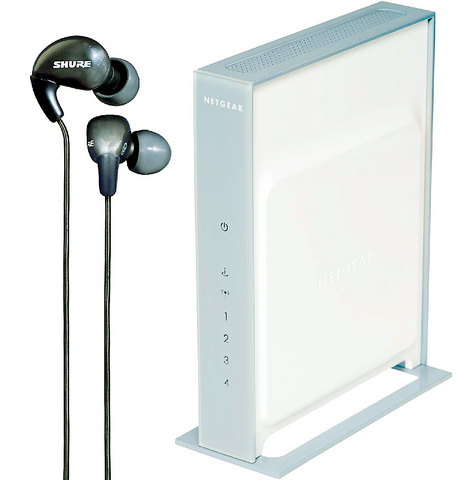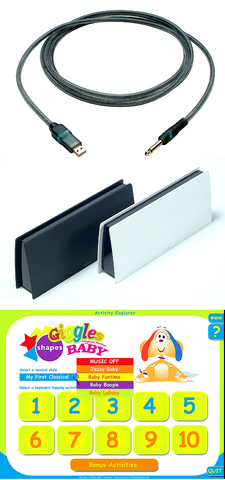Hear the noise or block it out
Filling your ears with music from noise-blocking earphones doesn't just diminish outside noises. It also reduces your ability to hear things you might want to, like traffic noise when you cross a street.
But taking the earphones in and out of your ears in these situations is a nuisance, so Shure is packaging a push-to-hear switch with its E500 earphones, which cut ambient noise by 30 to 37 decibels -- the equivalent of bringing airliner cabin noise down to about the level of a quiet conversation. Press it, and the music in the headphone mutes, while an external microphone picks up ambient sounds.

PHOTOS: NY TIMES NEWS SERVICE
The E500s will be priced at US$499 with the switch when they arrive in stores. (The switch, which will work with all standard earphones, will also be available separately at US$59.) The high price is partly because three miniature speakers are used in each earphone, a tweeter and two woofers, for better reproduction of high and low tones.
Modular cables for portable and home-stereo listening are included. And so are eight pairs of sleeves, to ensure that the E500 comfortably fills ears of any size.
For the impatient, even faster Wi-Fi

While most people are still figuring out Wi-Fi, along comes 802.11n, a faster wireless standard that transmits data up to four times as fast as the current Wi-Fi standard, 802.11g, and up to 20 times the speed of the earlier 802.11b.
Netgear's WNR834B wireless router, the latest in the RangeMax line, can accommodate all three varieties, and offers four Ethernet ports.
The router, which costs US$179, is best for transmitting large files around a closed network. For example, a business with the new router would notice a considerable speed improvement when sending data to and from office computers. The router's speed will have little effect on standard Web browsing.
The router and accompanying wireless notebook card, the WN511B (US$129), are available now online. One caveat that has to be considered is that, as with 802.11g before it, Netgear and other manufacturers are releasing routers and wireless cards before the 802.11n standard has been officially ratified by the US Institute of Electrical and Electronics Engineers.
Even if the standard is never ratified, however, the WNR834B will improve the transfer speed of video and multimedia content over a closed network.
It's baby's first video game
Living up to its name, Giggles Computer Funtime for Baby transforms a Mac or PC into a busy box. A baby sitting in your lap can bash, mouth or click the keyboard with few worries, other than a bit of drool.
Available for US$20 as a download or CD from www.giggles.net, the program starts with a menu for adults offering 10 exploration zones.
There's a farm where pressing any key makes an animal pop up on the screen, or a backyard scene where pressing any key makes a rabbit dance. When a child stops pressing, the action stops, too, helping children feel in control of a noisy, silly experience. A control panel lets parents toggle among five musical styles, from classical to bluegrass, and a screen saver mode makes some select games available whenever the computer is on.
Unlike many technology products for babies, the packaging makes no claims of creating an Einstein. What this program does is create an informal setting where a child can sit in a lap and freely explore what used to be forbidden territory: a parent's computer. Just don't be surprised when you find a raisin pressed into your numerical keypad.
More bang, more bucks
Bang & Olufsen, the Danish maker of high-end audio systems, has released the BeoLink Wireless 1 system, which delivers CD-quality audio to receivers that can cover up to seven rooms in a 27m range.
Each unit can receive audio and transmit it to other units and on to speakers, sold separately, by an infrared signal. The units cost US$450 apiece, plus US$50 for the infrared "eye" that transmits to wireless-enabled BeoLab speakers. With a wireless system, "the challenge for us was to create a system that could send signals around the entire house with no delay," said David Zapfel, Bang & Olufsen's North American product manager. But that challenge, he said, was met.
The system operates on the 2.5-giga-hertz band. Units, in black or white lacquer, may be placed on a shelf or mounted on a wall with brackets.
For owners of older Bang & Olufsen speakers who don't want to pay for newer, wireless-enabled ones, the system allows a hard-wire connection from each transmitter to the speakers using the company's proprietary Master Link cable system, also sold separately.
"That will work with any of the speakers we've released in the past 10 or 15 years," Zapfel said.
Snakes in the garage provide easy hookups for the band
Those who like to rock 'n' roll all night and party every day may be interested in the LightSnake, a self-contained PC audio system from SoundTech made to let musicians hook up their instruments with a minimum of fuss.
The LightSnake is a single cable with a standard USB port at one end and a 1/4-inch audio jack on the other. When it is plugged in, the ends of the cable light up and it is ready to serve as an audio input device on Windows and Macintosh PC's and laptops. The only thing left to do is plug in a guitar or other electric instrument for recording.
The 3m cord features built-in 16-bit digital sound processing hardware that improves and amplifies the audio before sending it to the PC. It requires no additional software on most operating systems.
The LightSnake is compatible with many digital audio recording programs, including GarageBand from Apple. Of course, a real garage band might consider a setup like this to be taking the stripped-down ethos a little too far.

The canonical shot of an East Asian city is a night skyline studded with towering apartment and office buildings, bright with neon and plastic signage, a landscape of energy and modernity. Another classic image is the same city seen from above, in which identical apartment towers march across the city, spilling out over nearby geography, like stylized soldiers colonizing new territory in a board game. Densely populated dynamic conurbations of money, technological innovation and convenience, it is hard to see the cities of East Asia as what they truly are: necropolises. Why is this? The East Asian development model, with

June 16 to June 22 The following flyer appeared on the streets of Hsinchu on June 12, 1895: “Taipei has already fallen to the Japanese barbarians, who have brought great misery to our land and people. We heard that the Japanese occupiers will tax our gardens, our houses, our bodies, and even our chickens, dogs, cows and pigs. They wear their hair wild, carve their teeth, tattoo their foreheads, wear strange clothes and speak a strange language. How can we be ruled by such people?” Posted by civilian militia leader Wu Tang-hsing (吳湯興), it was a call to arms to retake

This is a deeply unsettling period in Taiwan. Uncertainties are everywhere while everyone waits for a small army of other shoes to drop on nearly every front. During challenging times, interesting political changes can happen, yet all three major political parties are beset with scandals, strife and self-inflicted wounds. As the ruling party, the Democratic Progressive Party (DPP) is held accountable for not only the challenges to the party, but also the nation. Taiwan is geopolitically and economically under threat. Domestically, the administration is under siege by the opposition-controlled legislature and growing discontent with what opponents characterize as arrogant, autocratic

When Lisa, 20, laces into her ultra-high heels for her shift at a strip club in Ukraine’s Kharkiv, she knows that aside from dancing, she will have to comfort traumatized soldiers. Since Russia’s 2022 invasion, exhausted troops are the main clientele of the Flash Dancers club in the center of the northeastern city, just 20 kilometers from Russian forces. For some customers, it provides an “escape” from the war, said Valerya Zavatska — a 25-year-old law graduate who runs the club with her mother, an ex-dancer. But many are not there just for the show. They “want to talk about what hurts,” she